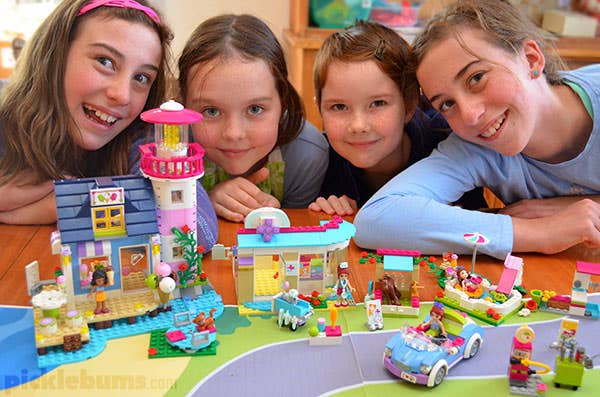Lego’s return to gender neutral toys is good news for all kids
Lego announced it would work to remove gender stereotypes from its brand, including no longer marketing toys distinctly to boys or girls.

[Oct 13, 2021: Naomi Priest, Tania King]
A trilobite fossil, Redlichia rex found at Emu Bay, Kangaroo Island – a marine creature that lived over 500 million years ago during the Cambrian period. (Credit: Creative Commons)
Lego announced this week it would work to remove gender stereotypes from its brand, including no longer marketing toys distinctly to boys or girls and ensuring products are gender-neutral.
This move by one of the world's most powerful brands comes in response to research the Danish toy manufacturer commissioned to understand how parents and children think about creativity.
The survey of nearly 7,000 parents and children across seven countries found strong endorsement of traditional gender roles among both boys and girls, with 78 percent of boys and 73 percent of girls agreeing "it's okay to teach boys to be boys and girls to be girls."
71 percent of boys were worried about being judged or made fun of for playing with toys gendered for girls and 54 percent of parents worry their sons will be made fun of if they play with toys associated with girls, compared to only 26 percent of parents worrying about the reverse.
Overall, the results suggest boys feel more pressure to conform to gender roles and norms for creative activities than girls. But the perceptions and beliefs of others may also be holding girls back. When toys are gendered, all children pay the price.
We recently conducted a systematic review of gender stereotypes and biases in early childhood.
Awareness of gender as a social category develops early in life, and insight into some gender stereotypes begins early. For example, preschool aged children can hold beliefs such as only boys can be policemen and only girls can be teachers or nurses.
Gender and racial stereotyping and prejudice can be observed in children as young as three to four years of age, as children take on cues from around them to decode and understand the world.
Shopping and 'fixing things'
When children observe different toys and tasks for different groups, they can learn stereotypes and prejudices, such as viewing shopping as an activity for girls and "fixing things" and using tools as activities for boys. This can reinforce rigid binary views of gender.
Such stereotypes and prejudices can be carried throughout life, making early childhood critical for setting the foundations for lifelong attitudes.
Teaching children construction toys ‘aren’t for girls’ can discourage girls going into STEM fields. (Credit: Shutterstock)
The Lego research found parents were more likely to encourage their daughters to engage in activities that are more cognitive, artistic and performative (dressing up, dancing, coloring, singing and arts and crafts), and more likely to encourage their sons to engage more in digital activities, science and building.
Beliefs and expectations about what types of toys and play are appropriate for girls and boys can compound over time.
Some studies show that play with some stereotypical girls' toys, such as princess toys, is associated with more female gender-stereotypical behavior among children.
Not engaging in play with construction toys may mean girls miss opportunities to develop spatial skills and mechanical reasoning skills necessary for careers in science, technology, engineering and mathematics: fields in which women continue to be under-represented.
Rigid gender lines
Toys are only one way in which children learn gender roles and stereotypes: they also learn from who they see around them in their daily lives, from the books they read and the TV shows they watch.
Parents and caregivers have a key role in encouraging children of all genders to engage with a wide range of activities and toys.
But since the 1970s, toys have become increasingly and rigidly demarcated along binary gender lines.
Even Lego's own marketing history demonstrates this: compare the gender neutral advertisements from the early 1980s to more recent gender specific marketing with pink bricks and heart shapes.
The prevention of potentially harmful gender attitudes and stereotypes in childhood—before they become entrenched—is a key element in moves to achieve gender equity and to support health and wellbeing throughout life.
Efforts to reduce the gendered nature of toys and their marketing is one step we can take to give all children more equitable options for how they see themselves, the world, and their future.
For more international good news stories check out our Global Good section at The Brighter Side of News.
Like these kind of feel good stories? Get the Brighter Side of News' newsletter.
Tags: #Global_Good_News, #Toys, #Lego, #Girls, #Gender_Neutral, #Business, #The_Brighter_Side_of_News
Joseph Shavit
Head Science News Writer | Communicating Innovation & Discovery
Based in Los Angeles, Joseph Shavit is an accomplished science journalist, head science news writer and co-founder at The Brighter Side of News, where he translates cutting-edge discoveries into compelling stories for a broad audience. With a strong background spanning science, business, product management, media leadership, and entrepreneurship, Joseph brings a unique perspective to science communication. His expertise allows him to uncover the intersection of technological advancements and market potential, shedding light on how groundbreaking research evolves into transformative products and industries.



